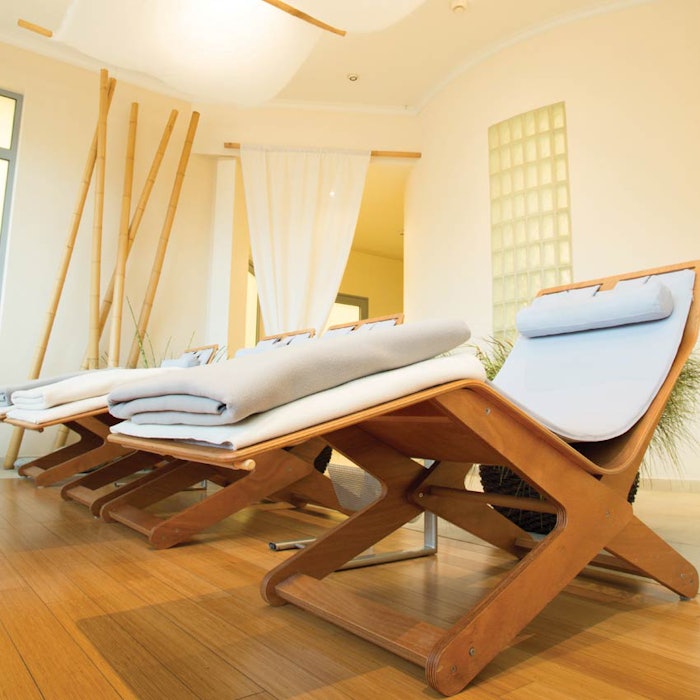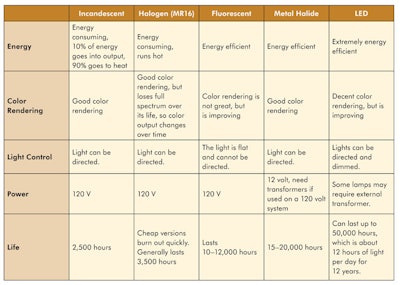
Lighting—it truly does make or break an interior. The right lighting can take a good design and turn it into a great design, or conversely take a great design and make it look mediocre. Lighting can also change the behavior of employees and clients, both positively and negatively. Unfortunately, lighting is often one of the last items to be considered when designing a new space, or retrofitting an existing one. Oftentimes, this is because lighting is an expensive and complicated endeavor, but ignoring lighting in a space is like cutting off your nose to spite your face. An investment in the proper lighting will almost certainly return its cost, if not make more, but lighting is complicated and technical.
To truly understand how to properly illuminate a room, one has to understand watts, lumens, foot-candles, voltage, photometrics, Kelvin temps and color rendering indices, just to start. Then there are diffusers, luminaries, dimmers, photocells and ballasts to understand. With rapidly changing technology, it can be challenging just to keep up with the latest versions of light emitting diodes (LEDs), much less updated lighting controls.
When considering new lighting for a spa, a few key elements must be thoughtfully reviewed. Here, we will discuss those elements, which can lead to proper illumination of a spa space.
The space’s purpose
The critical first step is to define the purpose of the space and the tasks to be conducted in the room. The mood of the reception area is obviously different from the treatment rooms, a retail space or a rest and rejuvenate room. Each space will require a different type of light or at the very least, a different light level.
Identify light type
The second step is to determine the type of light the tasks require. For example, one must decide if bright light or soft light are more appropriate. Similarly, would white light, soft-yellow light or cool-blue light be more appropriate? Then, one must determine if they want sharp or diffused light, and then determine if they need to direct or dim the light.
If clients will be looking at themselves in the mirror, skin color and lighting glare will be important factors to consider. Also, do not forget that lights can add heat to the room.
There are basically two different types of light to consider when illuminating the rooms in a spa—natural light and artificial light. Natural light is the most important light the client can be exposed to in a built environment. Humans are immediately attracted to natural light because it inherently affects biorhythms and enhances overall well-being. Except for times near dawn and dusk, it produces the best light to see colors in their truest form. Just be sure to control this light with window treatments, as a bright morning sun from the east or the hot western setting sun can wreak havoc on interior finishes over time, not to mention how it can increase cooling bills. If there is no access to exterior windows, try solar tubes. They are a great way to bring natural light into windowless rooms and spaces.
Artificial light is technology’s best attempt to recreate daylight. It comes in a variety of shapes and sizes. There are basically five lamp types that are used in today’s retail/service environments: incandescent, halogen, fluorescent, metal halide and LED (see Five Types of Artificial Lamps). Note that “lamp” is the commercial lighting industry’s term for light bulb. There are some safety concerns with specific types of lamps. Incandescent lamps can pose health issues via subtle flickering and UV radiation. Most incandescent bulbs contain small amounts of mercury, so they have to be disposed of properly. Conversely, LED lamps contain no mercury and are made of durable solid state compartments. The caveat to that, of course, is that LEDs are expensive, but those costs are recouped over time with lower utility bills. Whereas metal halides take a long time to produce a full light output, LED lamps turn on instantly. While LEDs run cool, they need “fins” to disperse the heat that is emitted. They are not affected by electromagnetic interference and can sustain moderate power surges and outages.

Determine wattage, lumen and FTC
Wattage is the amount of power required to operate lamps at full capacity, while lumen output is brightness and foot-candles (ft-c) are the amount of light that falls on a given surface. A lamp with low wattage needs a high lumen output. Saving on energy can mean duller light output if a lamp with high lumen output is not chosen.
Most commercial interiors will have an ambient light level of 30–50 ft-c. If tasks, such as skin procedures, require a high level of pure white light, the ft-c reading may need to be over 100. If there is a high ceiling over 12 feet, the lights may need to be dropped to 10 feet to get the proper level of lighting on the spa floor or work surfaces.
Artwork, signage and product displays should be illuminated with ft-c readings three times higher than the ambient light. Therefore, if a room has a general illumination of about 35 ft-c, the focal points should be illuminated to around 105 ft-c.
Determine light spread
When using lamps to direct light, such as track heads, there are several light spreads to choose from, including: narrow-spot, spot, narrow-flood and flood. If a small sign or piece of artwork is being highlighted, the narrow spot is sufficient. Washing an entire wall will require a flood lamp.
Color rendering index (CRI)
When it comes to the color rendering index (0–100) of the lamp, higher numbers will have a truer color under the light. If color matching needs to be done in the room such as with hair dye or makeup, look for a CRI higher than 90.
Determine the temperature of the light
Contrary to what you might think, higher numbers have cooler light. Therefore, daylight is 5,000–6,200 Kelvin (K). This is not recommended for most commercial interiors, unless you have an operating room in your spa!
A comfortable “visual” temperature is around 3,500K and the closest to a subdued “natural light.” For a warmer light that feels softer and more comfortable with some yellow/red tones, 3,200K will serve well. Spaces that require a more clinical look can move up to 4,200K, which will give a cooler, whiter light.
Purchase quality
If possible, buy lamps that are made in the United States, or be sure to get a good warranty on those purchased elsewhere.
Rules of thumb
When specifying lighting for a large room, mix light sources to avoid visual monotony. The human eye is attracted to contrast. If ceiling light fixtures—recessed or pendant—are providing the ambient light, then track lighting or recessed wall washers can be added to highlight specific areas of the space. Finally, table lamps, floor lamps, wall sconces or decorative pendant lights can bring some visual fun to the space.
When selecting lighting fixtures—the shades that surround the lamps—think about where the light is needed and what type of light is needed in the space. Fixtures can provide direct downlight, indirect light, a combination of downlight and indirect light or in the case of pendant lights, light can be emitted through parts or all of the shade. Indirect light is when the light shoots upward and reflects off the surface of the light fixture before heading back down to the room for a softer light on the floor.
Get the light right
Pay attention to lighting. Take time to learn about some of the basic advancements in LEDs. Audit lighting every couple of years. If lighting is not your forte or you simply do not have time, look into hiring an experienced lighting designer to audit the space and provide specifications for new lights. Also, talk to the local utility company, as many have services to not only audit lighting in a space, but also to help find energy efficient replacements. However, keep in mind that significantly more interest lies in the energy efficient aspect of your light output.
Finally, do not underestimate the power of lighting. Spas have many rooms that serve different functions. Getting the light right in each of the rooms is imperative. Do it right and enjoy the results.











